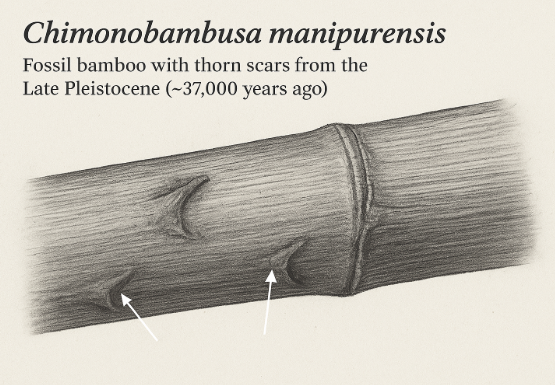Imphal, Nov 28: Scientists conducting a field survey in Manipur’s Imphal West district have discovered fossil evidence indicating that thorniness in bamboo was already present in Asia during the Ice Age, a government release said.
Researchers from the Birbal Sahni Institute of Palaeosciences (BSIP), an autonomous body under the Department of Science and Technology (DST), found a bamboo stem with unusual markings in silt-rich deposits along the Chirang River in Imphal Valley.
Their detailed analysis identified these as thorn scars, prompting further investigation into its identity and significance, it said.
The team studied the fossil’s morphology — including nodes, buds and thorn scars — in the laboratory and assigned it to the genus Chimonobambusa. Comparisons with living thorny bamboos such as Bambusa bambos and Chimonobambusa callosa helped reconstruct the plant’s defensive traits and ecological role.
“This is the first fossil evidence that thorniness in bamboo—a defence against herbivores—was already present in Asia during the Ice Age. Its preservation is particularly significant because it comes from a period of colder and drier global climates, when bamboo was wiped out in many other regions, including Europe. The fossil shows that while harsh Ice Age conditions restricted bamboo’s global distribution, Northeast India provided a safe refuge where the plant could continue to thrive,” the release said.
The discovery published in the journal Review of Palaeobotany and Palynology is remarkable for capturing fragile details like thorn scars—features that almost never fossilise. The finding also highlights the Indo-Burma biodiversity hotspot as a crucial refugium during the Ice Age. While colder and drier climates eliminated bamboo from places such as Europe, the warm and humid conditions of Northeast India allowed it to persist.
“This research by H Bhatia, P Kumari, NH Singh and G Srivastava adds a new dimension to our understanding of both bamboo evolution and regional climate history. It also emphasises the role of this part of Asia in safeguarding biodiversity during times of global stress, making the discovery not only a botanical milestone but also an important contribution to palaeoclimatic and biogeographic studies, the release added.
Meanwhile, geologist N Herojit Singh of Geological Survey of India, a member of the team which discovered the fossil, told PTI, “The fossil was discovered back in 2021-22 at the silt-rich deposits of ‘quaternary deposits exposed’ west of Senjam-Chirang village in Imphal West district. Several samples were collected, some of which measured nearly one feet.
Findings of the studies stated that the discovery of the “fossil bamboo culm” is from “late Pleistocene sediments in eastern India.” (PTI)




